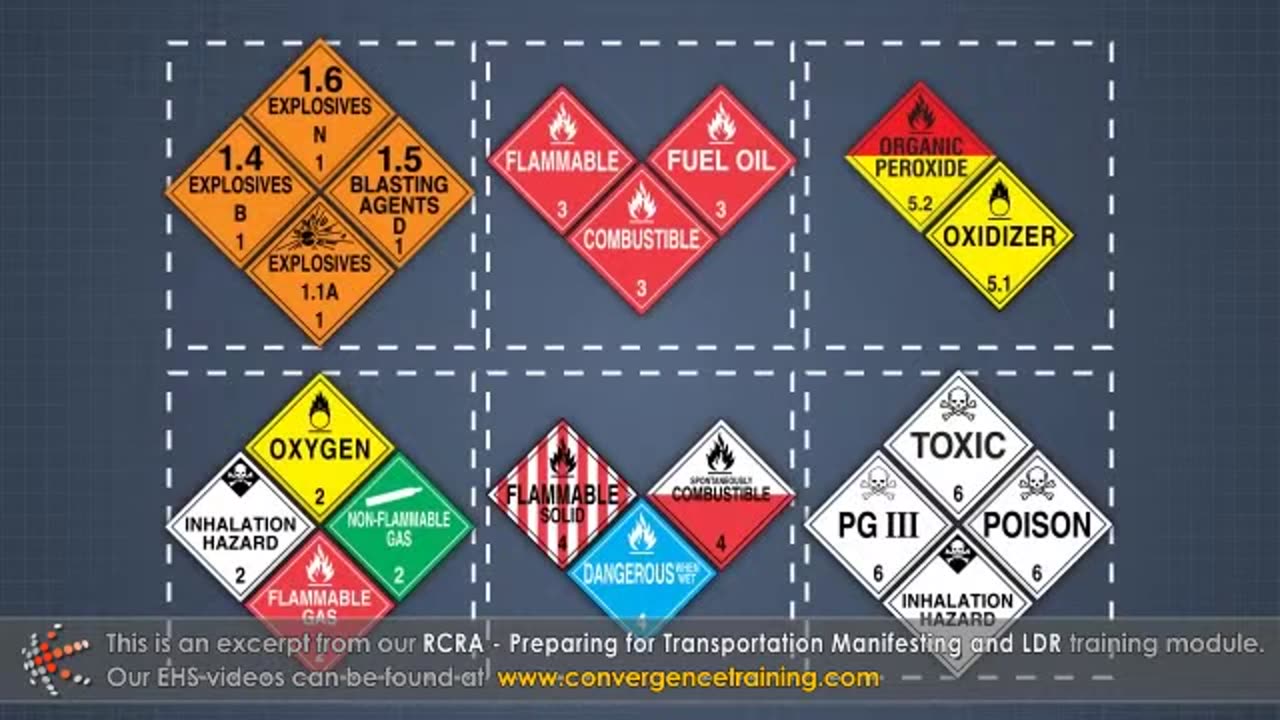Premium Only Content

RCRA - Preparing for Transportation, Manifesting, and LDR Training
### **RCRA Training: Preparing for Transportation, Manifesting, and Land Disposal Restrictions (LDR)**
This training ensures that employees involved in hazardous waste transportation and management understand the regulatory requirements for preparing waste for shipment, completing manifests, and complying with Land Disposal Restrictions (LDR). Here's a detailed outline:
---
### **1. Introduction to Hazardous Waste Transportation under RCRA**
- Overview of RCRA regulations for hazardous waste transport (40 CFR Part 262).
- Importance of compliance to ensure safe and lawful transportation.
- Agencies involved in regulation:
- Environmental Protection Agency (EPA).
- Department of Transportation (DOT).
---
### **2. Preparing Hazardous Waste for Transportation**
- **Packaging and Labeling**:
- Ensuring waste is packaged in DOT-approved containers.
- Proper labeling with hazardous waste descriptions, waste codes, and hazard classes.
- Marking containers with the generator’s information and accumulation start date.
- **Securing Loads**:
- Preventing leaks, spills, and damage during transportation.
- **Placarding Requirements**:
- Ensuring vehicles display appropriate DOT placards for hazardous materials.
---
### **3. Understanding the Uniform Hazardous Waste Manifest**
- **Purpose of the Manifest**:
- A tracking document required for cradle-to-grave waste management.
- **Completing the Manifest**:
- Sections of the manifest and required information:
- Generator details, waste description, quantity, transporter, and TSDF.
- EPA ID numbers for generators, transporters, and TSDFs.
- **Signatures and Distribution**:
- Ensuring all parties (generator, transporter, TSDF) sign the manifest.
- Retaining copies for recordkeeping:
- Generators: Keep for at least three years.
- **e-Manifest System**:
- Overview of EPA's electronic manifest (e-Manifest) system.
---
### **4. Land Disposal Restrictions (LDR)**
- **Purpose of LDR**:
- Preventing disposal of untreated hazardous waste in landfills.
- Encouraging treatment to reduce toxicity and mobility.
- **LDR Notification and Certification**:
- Requirements for providing LDR forms with hazardous waste shipments.
- Identifying treatment standards and waste codes on forms.
- **Treatment Standards**:
- Understanding required treatment methods (e.g., stabilization, neutralization).
- Ensuring waste meets LDR treatment standards before disposal.
---
### **5. Transportation Responsibilities**
- **Generator Responsibilities**:
- Proper waste identification and classification.
- Selecting permitted transporters and TSDFs.
- **Transporter Requirements**:
- Maintaining compliance with DOT and RCRA regulations.
- Immediate reporting of spills or accidents during transportation.
- **TSDF Responsibilities**:
- Confirming waste receipt and managing proper treatment/disposal.
---
### **6. Spill and Emergency Procedures**
- Steps to take in the event of a spill or accident during transportation.
- Notification requirements for transporters and generators.
- Emergency response plans and coordination with local authorities.
---
### **7. Recordkeeping and Reporting**
- Retaining manifests, LDR notifications, and shipment records for at least three years.
- Reporting discrepancies between shipped and received waste.
- Preparing for EPA inspections and audits.
---
### **8. Common Violations and Best Practices**
- **Common Violations**:
- Incorrect waste classification, incomplete manifests, and non-compliant packaging.
- **Best Practices**:
- Regularly reviewing RCRA and DOT requirements.
- Conducting periodic internal audits.
- Training all personnel involved in waste transportation.
---
### **9. Training Requirements**
- **Who Needs Training**:
- Employees preparing hazardous waste for transport.
- Staff completing manifests or handling LDR compliance.
- **Frequency**:
- Initial training for new employees.
- Annual refresher training to address updates or changes in regulations.
---
### **10. Closing and Resources**
- Recap of key responsibilities and procedures.
- Resources for further reference:
- EPA’s RCRA guidance materials.
- DOT’s Hazardous Materials Regulations (HMR).
- Open Q&A session for facility-specific concerns.
---
**Optional Enhancements**:
- **Hands-On Training**: Practice completing a sample hazardous waste manifest and LDR form.
- **Quizzes and Assessments**: Test participant understanding of manifesting and LDR requirements.
- **Resource Materials**: Checklists, templates, and quick reference guides for manifests and LDR forms.
Would you like help creating specific materials like sample manifests, LDR forms, or interactive exercises for this training?
-
 6:43
6:43
HSESafetyInformation
5 months agoLahori Chanay Recipe - Lahori Cholay Recipe - Chana Chana Masala
53 -
 2:04:46
2:04:46
Tim Pool
2 hours agoEpstein Scandal WON'T GO AWAY, Does Epstein MATTER To MAGA? | The Culture War
104K88 -
 LIVE
LIVE
The Charlie Kirk Show
1 hour agoThe WSJ Nothingburger + No Amnesty Means NO AMNESTY + The Jobs AI Won't Do | Rowe | 7.18.25
3,512 watching -
 LIVE
LIVE
The Big Mig™
1 hour agoGlobal Finance Forum From Bullion To Borders We Cover It All
52 watching -
 LIVE
LIVE
Rebel News
53 minutes agoFord urges Poilievre to be liberal, Canada’s crime spikes, Quebec church burns | Rebel Roundtable
304 watching -
 LIVE
LIVE
The Mel K Show
2 hours agoMORNINGS WITH MEL K -Our Kids Are Not Alright-The People Must Push Back Now! 7-18-25
932 watching -
 LIVE
LIVE
Flyover Conservatives
12 hours agoThe Fountain of Youth? Red Light Therapy for Longer Life - Jonathan Otto | FOC Show
317 watching -
 DVR
DVR
The Shannon Joy Show
19 hours ago🔥🔥URGENT! Dutch Medical Freedom Attorney Arno van Kessle Arrested And Held Without Charge - Live EXCLUSIVE With Jim Ferguson!🔥🔥
4.5K2 -
 1:00:40
1:00:40
Dr. Eric Berg
4 days agoThe Dr. Berg Show LIVE July 18, 2025
9.99K3 -
 44:40
44:40
The Rubin Report
3 hours agoThis Is Why Gavin Newsom Regrets Letting Shawn Ryan Interview Him with Co-Host Riley Gaines
50K42